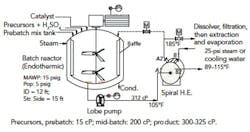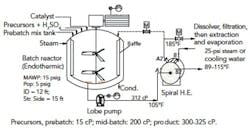Puzzler: Mind The Mettle Of Packing Materials
This Month’s Puzzler
We just replaced a high-density polypropylene (HDPP) mesh pad and glass-filled polypropylene packing at the top of our distillation tower with a metal mesh pad and metal packing. We had installed the packing and mesh pad because we needed greater efficiency than we were getting with the simple tray design below in the tower. Unfortunately, we now can’t seem to make purity in the condenser.
Operations was concerned about spikes in temperature beyond 200°F during start-up and maintenance’s desire to steam the packing and pad to speed up cleaning. Our condenser set point is 162°F. The project engineer fought long and hard against the metal replacement because he says it’s less efficient than the HDPP and can crust over, making removal difficult.
Maintenance also worries about carryover of broken mesh into the condenser and product. Quality control has seen no sign of mesh in the three years we have used HDPP packing.
Even with that concern, maintenance said a bed limiter wasn’t needed for metal packing like it was for plastic. So, one wasn’t installed with the metal packing.
Currently, cleaning the distillation tower involves washing with a detergent and then muriatic acid, followed by hot water. Maintenance insists that a high-pressure gun easily can steam clean the metal packing and metal mesh.
Did we make the right choice? Is there any other way to get higher efficiency in the upper section of the distillation tower? What kind of trouble might we face using metal packing and a metal mesh pad?
Investigate Various Issues
Look into four key aspects:
1. Check liquid and vapor flows in the column. Do a pressure and temperature survey on the column. Issues such as channeling, liquid or vapor maldistribution or flooding could cause purity problems. If the project also involved changing the size or configuration of the overhead condenser, make sure flow of cooling medium is adequate and air has been vented, and address any other issues that could impair condensation.
2. Compare the current operation with that with HDPP packing. If the rates are comparable to those in the HDPP column, then evaluate the possibility of liquid/vapor maldistribution:
• The liquid distributor may not have been installed properly (not plumb level). Try varying liquid traffic and boil-up to see if you get improvement in product quality. If you don’t get any improvement, misalignment is a possibility.
• Fouling may afflict the liquid distributor. (The problem statement doesn’t say if the liquid feed is fouling or corrosive.)
• Poor vapor distribution, though not as common as liquid maldistribution, could exist for large columns.
• You might consider X-raying the column to get visual confirmation about mis-installation of internals. This approach, though effective, is cost-intensive. However, a possible reduction in shutdown duration (because of more effective planning of repairs) might more than compensate.
3. Check the design basis used for changing HDPP to metal packing/demister.
• Compare the HETP used for metal packing with that of plastic packing — they should be comparable.
• Likewise, the HDPP and metal designs for the liquid distributor and other internals should be similar.
• If significant carryover of packing (to the condenser system) occurs, a bed limiter would be beneficial. Because metal is heavier than plastic, there’s less of a need for a bed limiter with metal packing than plastic packing, strictly on a weight basis. However, you also should account for abnormal operations, sudden spikes in vapor flows, start-up and shut-down conditions.
• Packing is available in various sizes and configurations such as pall rings, snow flake, tri-pack and many others. Some of the configurations may be prone to locking (of adjacent packing) which could cause lower separation efficiency. Check with the vendor.
4. Your vendor can provide information on wettability of metal versus plastic packing. Some literature indicates minimum flows for good wettability are lower for metal than for plastic packing; metal packing seems to be more “tolerant” than plastic packing as far as wettability goes. However, the type of fluid, temperature and pressure as well as the particular metal and metal structure could influence wettability.
GC Shah, consultant
Houston
Consider Metal’s Downside
My experience steam-cleaning metal mesh pads belies your maintenance engineer’s experience. Metal mesh pads are inflexible and easily become encrusted. These encrustations are difficult, perhaps impossible, to remove without damaging the pads. In addition, damaged metal pads cost about four times as much as HDPP packing to replace — and require 4–8 weeks lead time while HDPP packing usually is available via next day air.
As for performance, HDPP pads are more efficient than metal ones. It’s easier to weave strands of plastic than metal, so a finer weave is possible. By the way, the absorption coefficient for “packing” for any mesh pad typically is 4–5 times greater than the best random packing available today. This is true even for a metal mesh pad.
Wetting is very important with random packing and mesh; a thick fluid layer is preferred. So, the fluid should have good affinity to the material. Water and plastic packing have poor affinity; oil and plastic have good affinity. Water and metal have excellent affinity; oil and metal have poor affinity. Plastics and ceramics initially have poor affinity for water but this dissipates somewhat after the first couple of days’ operation.
Obviously, the HDPP packing performed better than the metal packing. The engineering before the installation should have included a review of the performance of the two materials. I’ve been in the situation overseas where packing was switched without notice. Fortunately, I always kept an ace up my sleeve: the pumps always were oversized 10–20% to compensate for some loss in packing performance.
While maintenance may have some concerns about cleaning, your engineer can use the muriatic acid on the HDPP and allow for a soak. With a little patience, this should provide the sought-after results.
Dirk Willard, consultant
Wooster, Ohio
September’s Puzzler
I’m a new process engineer hired to sort out a botched expansion. The plant tried to increase production by replacing our reliable pressurized batch reactor with a vessel with double the capacity. The new system (Figure 1) has operated for three months but isn’t performing well.
Figure 1. New reactor has twice the capacity of old, trouble-free unit, but poses all sorts of problems.
In the new setup, we boosted the agitation by a factor of 30% but kept the same heat exchanger because, according to corporate, it was oversized by a factor of two — now, the capacity matches the theoretical heat load. In addition, we increased the pump motor size and added a variable frequency drive — before the scale-up, the pump ran at the bottom of its curve. We retained the steam control valve; the cooling water is on an open-closed valve. We got rid of the bottom shell baffle and also the pre-batch tank, which our researchers believe we don’t need. We largely duplicated everything else. The previous plant owners left scant records, so we had to go by modeling. The designers didn’t bother talking to any of the operators; it was a hostile takeover so the old managers and engineers aren’t cooperating.
I inspected the old vessel in the boneyard and noticed the bottom baffle was added later; the code stamp agrees. The agitation nozzle appears to have been beefed up, perhaps afterwards as well. I checked the motor and it’s always been in the same bucket.
Currently, we’re having difficulty starting the reactor. We also are having trouble cooling it down between batches. The relief valve on the vessel has popped twice in the past month — an operator told me that never happened before. The valve sticks open when it relieves. The viscosity is lower than expected, about 180 cP, suggesting a reversal of the reaction or incomplete reaction, and the temperature spikes above 180°F at the reactor outlet. I had the operators reduce the batch size by 30% and we seem to be making good product with the process in control.
Further complicating my troubleshooting, the new management changed the batch ingredients. The surviving laboratory technician from the old days says the viscosities and densities are higher.
What was done wrong? How can we get this process producing at the desired rate?
Send us your comments, suggestions or solutions for this question by August 13, 2021. We’ll include as many of them as possible in the September 2021 issue and all on ChemicalProcessing.com. Send visuals — a sketch is fine. E-mail us at [email protected] or mail to Process Puzzler, Chemical Processing, 1501 E. Woodfield Rd., Suite 400N, Schaumburg, IL 60173. Fax: (630) 467-1120. Please include your name, title, location and company affiliation in the response.
And, of course, if you have a process problem you’d like to pose to our readers, send it along and we’ll be pleased to consider it for publication.

